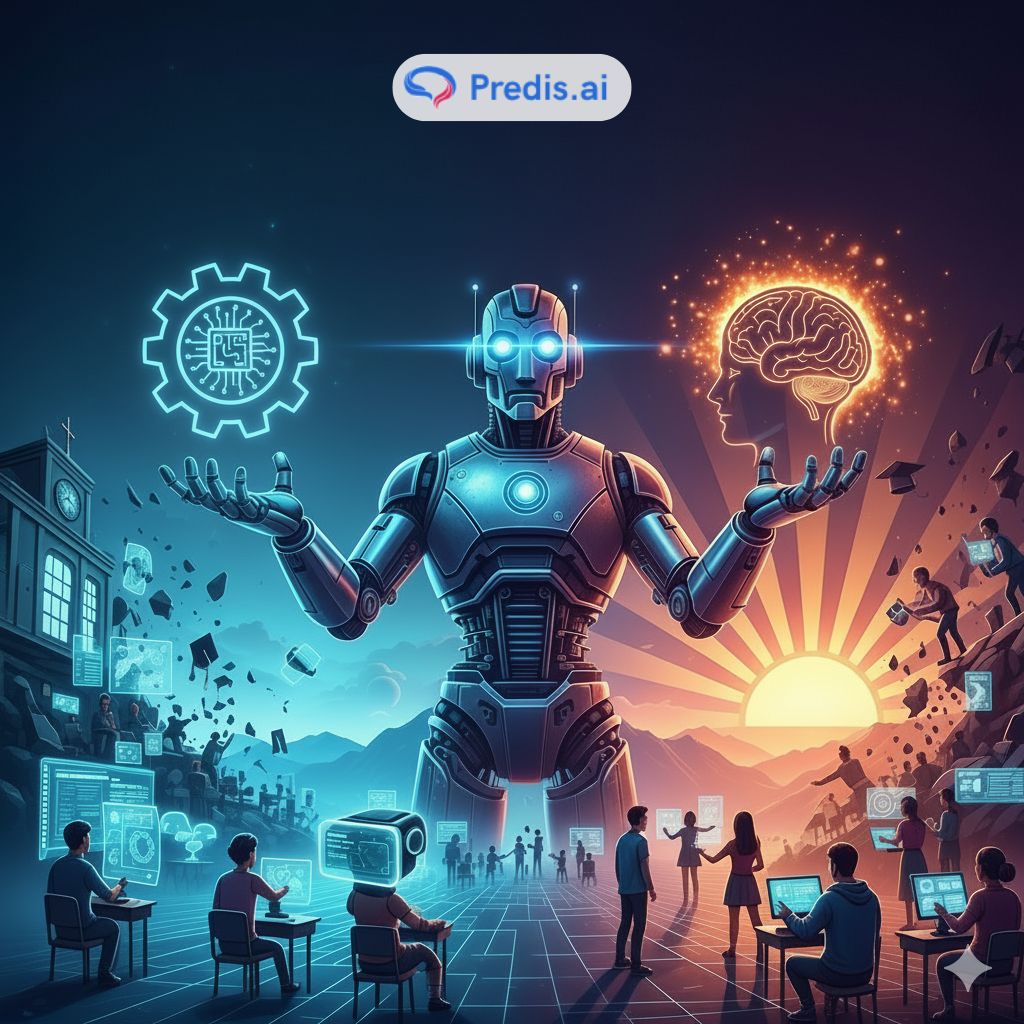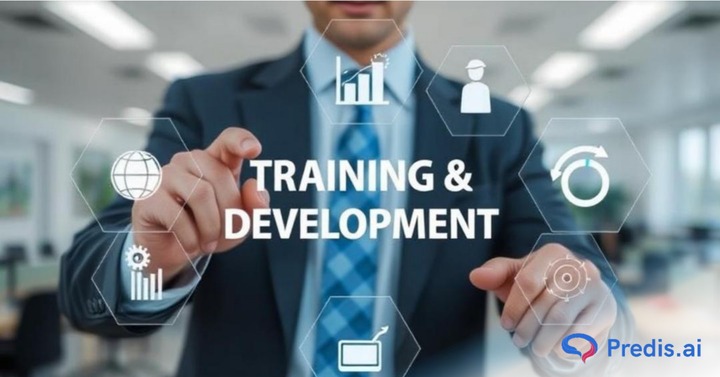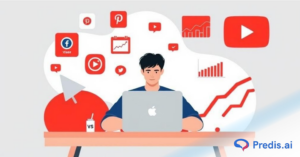Did you know that according to LinkedIn’s Workplace Learning Report, 77% of L&D professionals believe AI will play a crucial role in personalized learning over the next five years? The shift isn’t just a prediction, it’s already happening. More organizations are integrating AI into their training models to make learning smarter, faster, and more engaging.
So, what exactly does AI for Training and Development mean? At its core, it’s the use of artificial intelligence tools like learning platforms, chatbots, predictive analytics, and content generators to design, deliver, and improve workplace learning. Instead of a one-size-fits-all approach, AI enables adaptive learning experiences that respond to each employee’s pace, strengths, and gaps.
Organizations across industries are steadily moving away from traditional, manual training methods and turning toward AI-powered learning solutions. From automating skill assessments to offering real-time feedback, AI makes the entire learning journey more interactive and scalable.
This blog will walk you through why AI for Training and Development is such a game-changer and break down practical ways to start using it. By the end, you’ll see not only the benefits but also the steps you can take to implement AI in your own training programs.
TL;DR 🖋
AI is reshaping how organizations train employees, making learning more personalized, scalable, and effective. Instead of generic programs, AI-powered tools help tailor content, analyze performance, and create engaging learning experiences. Here are the main types of tools you can use:
- AI-Powered LMS – Automates course recommendations, tracks progress, and personalizes learning paths.
- Virtual Coaches & Chatbots – Offer 24/7 guidance, answer questions instantly, and support self-paced learning.
- AI Content Creation Tools – Generate quizzes, videos, and scenario-based modules quickly.
- Analytics & Reporting Tools – Measure engagement, identify skill gaps, and forecast future training needs.
- Gamification & Simulation Tools – Create adaptive role-play scenarios with real-time feedback.
- AR/VR with AI Integration – Deliver immersive, risk-free training environments for hands-on skills.
Why AI for Training and Development is a Game-Changer?
The way employees learn at work has changed dramatically. Traditional training methods static presentations, generic courses, and classroom-style sessions often fail to keep pace with today’s fast-moving workplaces.

This is where AI for Training and Development comes in. By combining data, personalization, and automation, AI transforms learning from a one-size-fits-all approach into a dynamic, interactive experience.
1. Personalized Learning Experiences
- One of the biggest strengths of AI for Training and Development is its ability to personalize learning.
- Instead of pushing every employee through the same modules, AI creates adaptive learning paths.
- It identifies skill gaps, monitors progress, and adjusts the pace of training accordingly. For example, an employee struggling with compliance guidelines may be assigned extra practice modules, while someone excelling in leadership skills can be fast-tracked to advanced training.
AI-driven assessments and smart recommendations ensure employees always get content that’s relevant to their role and growth. For recruiters, leading the shift to AI-driven talent acquisition requires upskilling, our guide highlights the best AI recruiter certification programs for high-impact performance.
2. Data-Driven Insights for Better Learning Outcomes
- AI doesn’t just deliver content, it collects and analyzes data at every stage. It tracks engagement levels, course completion rates, and knowledge retention, giving L&D teams a clear view of what’s working and what isn’t.
- These insights go beyond simple metrics. With predictive analytics, AI can forecast which employees are likely to fall behind or which training programs deliver the best results.
- This makes it easier to refine strategies and design training that genuinely improves performance. Some organizations also rely on ReactJS development to build clear, interactive dashboards that help L&D teams interpret AI-driven insights more easily.
3. Enhanced Engagement and Interactivity
- Traditional training often struggles to hold attention.
- AI solves this with interactive tools like chatbots, gamified modules, and simulations. Imagine employees practicing real-world scenarios in a safe, virtual environment where AI adapts challenges based on their responses.
- This kind of immersive learning not only makes training more engaging but also helps employees build confidence in applying their skills to real situations.
4. Scalability and Cost-Efficiency
- Rolling out training to hundreds or thousands of employees can be expensive and time-consuming. With AI, organizations can scale their programs effortlessly.
- Once set up, AI-powered learning platforms deliver consistent training across locations and teams without extra manual effort.
- Trainers save time on administrative tasks like grading and tracking, allowing them to focus on strategic initiatives. The result? A significant reduction in costs while improving reach and effectiveness.
5. Continuous Learning and Real-Time Feedback
- Instead of waiting for end-of-course evaluations, AI provides feedback in the moment.
- Employees can take instant quizzes, receive AI-generated feedback, and get nudges to revisit areas they haven’t mastered yet.
- This kind of real-time correction encourages continuous learning and prevents knowledge gaps from widening.
- Over time, it builds a culture where learning isn’t just a one-off event but an ongoing process.

Practical Applications of AI in Training and Development
Organizations today are using AI not just as a supporting tool, but as the backbone of their training strategies. From intelligent learning platforms that personalize content to virtual coaches that guide employees in real time, AI for Training and Development is reshaping how skills are built and retained. Let’s explore some of the most effective applications that are already making a difference.

1. AI-Powered Learning Platforms
- AI-enabled LMS tracks employee performance and learning habits automatically. Organizations often work with a ReactJS development company to build interactive, responsive dashboards that make this data accessible and actionable.
- Recommends personalized modules and resources based on progress and skill gaps.
- Saves managers’ time by automating course assignments.
- Ensures employees receive content that matches their individual development needs.
- Example: An LMS suggests advanced leadership courses to high performers while offering extra practice modules for those needing improvement.
2. Virtual Coaches and Chatbots
- Provide 24/7 access to learning support and mentorship.
- Employees can ask questions, get clarifications, or revisit topics anytime.
- Chatbots break down complex topics into simple, step-by-step guidance.
- Encourage self-paced learning, reducing reliance on trainers.
- Improves learner confidence by making help instantly available.
3. Intelligent Content Creation
- AI Tools generates training materials like quizzes, videos, and case studies in minutes.
- Converts existing company documents into interactive learning resources.
- Keeps training materials up to date with minimal manual effort.
- Customizes content to different employee roles and levels.
- Cuts down content development time significantly for L&D teams.
4. Gamification and Simulations
- Creates role-play scenarios for real-world challenges (sales, healthcare, leadership).
- Tracks learner choices and adapts difficulty levels based on responses.
- Boosts engagement with points, rewards, and progress tracking.
- Allows employees to practice skills in a safe, low-risk environment.
- Builds problem-solving and decision-making confidence.
5. Skill Gap Analysis and Workforce Planning
- AI analyzes employee performance data and compares it with benchmarks.
- Identifies skill gaps at both individual and organizational levels.
- Helps HR and L&D teams design training programs that target specific needs.
- Provides predictive insights into future skills employees will need.
- Supports long-term workforce planning and career development.
How to Implement AI for Training and Development in Your Organization?
Adopting AI in training isn’t about replacing human trainers it’s about making learning smarter, faster, and more effective. To make the shift successful, organizations need a clear roadmap. Here’s a step-by-step guide on how to implement AI for Training and Development in a way that creates lasting impact.
1. Identify Learning Objectives and Challenges
- Start by clarifying what you want AI to solve.
- Common focus areas include onboarding, compliance training, leadership development, and continuous upskilling.
- Pinpoint existing challenges, such as low engagement, poor knowledge retention, or high training costs.
- Once you know your objectives, it’s easier to choose the right AI tools that align with your goals.
2. Choose the Right AI Tools or Platforms
- Look for AI-powered learning platforms or add-ons that integrate seamlessly with your existing LMS.
- Consider scalability will the tool work for 50 employees as well as 5,000?
- Prioritize user-friendly platforms that keep employees engaged rather than overwhelmed.
- Ensure the platform offers strong reporting and analytics to measure effectiveness.
- Compare multiple solutions before committing to one.
3. Start with Pilot Programs
- Instead of overhauling your entire training system, begin with a small pilot group.
- Test AI-driven modules in one area, such as onboarding or compliance.
- Gather feedback from employees and managers to understand usability and effectiveness.
- Refine the content and delivery based on real-world results before scaling across the organization.
4. Blend AI with Human Expertise
- AI is powerful, but it works best when paired with human trainers and mentors.
- Trainers can provide emotional intelligence, encouragement, and real-world insights that AI can’t replicate.
- Use AI agents for personalization, automation, and analytics, while humans handle coaching, discussions, and leadership development.
- This blended model ensures learning stays both efficient and human-centered.
5. Monitor, Analyze, and Evolve
- Use AI analytics to track employee progress, engagement, and overall training ROI.
- Identify patterns—are employees dropping out of certain modules? Are specific programs improving performance?
- Keep refining content and delivery based on these insights.
- Treat AI-powered training as an evolving system that adapts to changing workforce needs.
Types of AI Tools to Use for Training and Development
To make the most of AI in workplace learning, it helps to know the different types of tools available. Each plays a unique role in improving efficiency, engagement, and results. Here are the main categories of AI tools for Training and Development and how they can be used:
1. AI-Powered Learning Management Systems (LMS)
- Automate course recommendations based on employee performance and skill gaps.
- Track progress in real time with detailed analytics.
- Personalize training paths for different roles and experience levels.
- Examples: platforms like Docebo, Cornerstone, or Moodle with AI integrations.
2. Virtual Coaches and Chatbots
- Provide employees with 24/7 training support and guidance.
- Answer questions instantly, reducing dependency on human trainers.
- Act as interactive learning companions that encourage self-paced study.
- Useful for onboarding, compliance training, and knowledge reinforcement.
3. AI Content Creation Tools
- Generate training modules, quizzes, and scenario-based exercises quickly.
- Convert company documents into interactive learning resources.
- Speed up course development for L&D teams.
- Examples: Synthesia (AI video creation), ChatGPT-based content tools.
4. AI Analytics and Reporting Tools
- Measure training effectiveness with advanced dashboards.
- Identify patterns like drop-off rates or high-performing modules.
- Use predictive analytics to anticipate skills employees will need in the future.
- Help HR and L&D teams prove ROI on training investments.
5. AI-Powered Gamification and Simulation Tools
- Create role-play environments for sales, healthcare, or leadership training.
- Adjust difficulty based on employee performance in real time.
- Improve engagement through points, badges, and rewards.
- Examples: AI-enhanced VR platforms for immersive learning.
6. AR/VR with AI Integration
- Combine AI with Augmented and Virtual Reality for realistic, hands-on training.
- Simulate real-world challenges without risk—like medical procedures or crisis management.
- Provide adaptive feedback during simulations to improve skill-building.
- Perfect for industries that rely heavily on practical application.
Future of AI for Training and Development
The use of AI in workplace learning is still evolving, and the possibilities ahead are even more exciting. As technology advances, organizations will see training programs move beyond simple personalization toward fully predictive and immersive experiences, especially with the growing adoption of AI courses that help professionals upskill and stay ahead in this evolving landscape. Here’s a look at what’s coming next in AI for Training and Development.
1. Predictive Learning and Future Skill Building
- AI won’t just react to employee needs—it will anticipate them.
- Predictive learning models will analyze workforce trends and forecast the skills employees will need for future roles.
- For example, AI could flag that a team will need stronger data literacy within two years and automatically design upskilling programs.
- This proactive approach ensures companies stay ahead of industry shifts while employees remain future-ready.
2. Integration with AR/VR for Immersive Learning
- The future of training is highly immersive. By integrating AI with AR (Augmented Reality) and VR (Virtual Reality), employees will learn in simulated environments that mirror real-world scenarios.
- Picture medical students practicing complex surgeries or customer service teams handling simulated client interactions—without any real-world risks.
- AI enhances these experiences by adapting difficulty levels and offering real-time feedback, making the learning process both practical and engaging.
3. Fully Adaptive, Personalized Career Development Journeys
- Training will move from isolated programs to continuous, career-long development journeys.
- AI will create tailored pathways for each employee, adjusting training modules based on evolving skills, performance, and career goals.
- Instead of a static annual training plan, employees will experience a living, adaptive roadmap that grows with them.
- This shift means training won’t just prepare employees for their current roles—it will actively guide their long-term career development.
Conclusion
AI is transforming Training and Development by making learning more personalized, data-driven, and engaging. From tailoring content to each employee’s needs to offering real-time feedback and predictive insights, it’s changing the way organizations approach workforce growth.
The key is that companies don’t need to overhaul everything at once. By starting small through pilot programs or focused training areasnorganizations can gradually scale AI-powered solutions and see measurable improvements along the way.
And here’s the most important point: AI isn’t here to replace trainers or mentors. Instead, it enhances the learning ecosystem by handling automation, personalization, and analytics, while human trainers provide the empathy, context, and leadership that technology can’t. Together, they create a powerful balance that prepares employees not just for today, but for the future of work.















